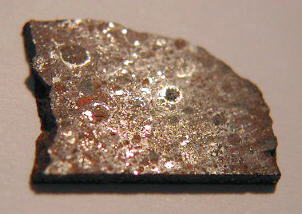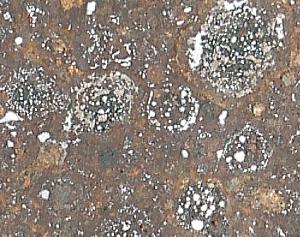C3-ungrouped w/ CV/CR affinities
(related to HaH 073 and possibly to the Coolidge–Loongana grouplet)

Found January 2000
z° 06′ 13′ N., w° 09′ 35′ W. A single stone weighing 70 g was found by the Labenne Family while searching for meteorites in the Sahara. This carbonaceous chondriteCarbonaceous chondrites represent the most primitive rock samples of our solar system. This rare (less than 5% of all meteorite falls) class of meteorites are a time capsule from the earliest days in the formation of our solar system. They are divided into the following compositional groups that, other than Click on Term to Read More contains metal-rich, multi-layered chondrulesRoughly spherical aggregate of coarse crystals formed from the rapid cooling and solidification of a melt at ~1400 ° C. Large numbers of chondrules are found in all chondrites except for the CI group of carbonaceous chondrites. Chondrules are typically 0.5-2 mm in diameter and are usually composed of olivine Click on Term to Read More up to 3 mm (ave. 790 µm) in diameter that are texturally similar to those in the CR group. These concentrically layered chondrules reflect early nebular activity in which multiple phases of aggregation and heating occurred.
The cores of these chondrules are composed of Mg-rich
silicateThe most abundant group of minerals in Earth's crust, the structure of silicates are dominated by the silica tetrahedron, SiO44-, with metal ions occurring between tetrahedra). The mesodesmic bonds of the silicon tetrahedron allow extensive polymerization and silicates are classified according to the amount of linking that occurs between the and/or
metalElement that readily forms cations and has metallic bonds; sometimes said to be similar to a cation in a cloud of electrons. The metals are one of the three groups of elements as distinguished by their ionization and bonding properties, along with the metalloids and nonmetals. A diagonal line drawn Click on Term to Read More that was once in a partially to completely molten state producing barred or
cryptocrystallineCrypto meaning "hidden" refers to a rock texture in which individual crystals are too small to be distinguished even using a standard petrographic microscope. Crystals are typically less than a few μm in size - any smaller and the texture would be considered amorphous. Among sedimentary terrestrial rocks, chert and Click on Term to Read More textures, respectively. Surrounding the
coreIn the context of planetary formation, the core is the central region of a large differentiated asteroid, planet or moon and made up of denser materials than the surrounding mantle and crust. For example, the cores of the Earth, the terrestrial planets and differentiated asteroids are rich in metallic iron-nickel. Click on Term to Read More is a layer composed of metal blebs, which either condensed directly from the
nebulaAn immense interstellar, diffuse cloud of gas and dust from which a central star and surrounding planets and planetesimals condense and accrete. The properties of nebulae vary enormously and depend on their composition as well as the environment in which they are situated. Emission nebula are powered by young, massive Click on Term to Read More or was the result of
reductionOxidation and reduction together are called redox (reduction and oxidation) and generally characterized by the transfer of electrons between chemical species, like molecules, atoms or ions, where one species undergoes oxidation, a loss of electrons, while another species undergoes reduction, a gain of electrons. This transfer of electrons between reactants Click on Term to Read More processes in the
chondruleRoughly spherical aggregate of coarse crystals formed from the rapid cooling and solidification of a melt at ~1400 ° C. Large numbers of chondrules are found in all chondrites except for the CI group of carbonaceous chondrites. Chondrules are typically 0.5-2 mm in diameter and are usually composed of olivine Click on Term to Read More. The next layer to be accreted, composed of
olivineGroup of silicate minerals, (Mg,Fe)2SiO4, with the compositional endpoints of forsterite (Mg2SiO4) and fayalite (Fe2SiO4). Olivine is commonly found in all chondrites within both the matrix and chondrules, achondrites including most primitive achondrites and some evolved achondrites, in pallasites as large yellow-green crystals (brown when terrestrialized), in the silicate portion Click on Term to Read More and/or
pyroxeneA class of silicate (SiO3) minerals that form a solid solution between iron and magnesium and can contain up to 50% calcium. Pyroxenes are important rock forming minerals and critical to understanding igneous processes. For more detailed information, please read the Pyroxene Group article found in the Meteoritics & Classification category. Click on Term to Read More, exhibits enrichments in FeO and depletions in CrO compared to other CR
chondritesChondrites are the most common meteorites accounting for ~84% of falls. Chondrites are comprised mostly of Fe- and Mg-bearing silicate minerals (found in both chondrules and fine grained matrix), reduced Fe/Ni metal (found in various states like large blebs, small grains and/or even chondrule rims), and various refractory inclusions (such Click on Term to Read More studied, suggesting that this material experienced higher-temperature metamorphism or melting in a transient heating event (Kakazu
et al., 2007).
Surrounding some type-I chondrules is a silica-rich outer rim composed of
tridymiteSilica group mineral in which the tetrahedra occur in sheets. Tetrahedra alternately point up or down to share oxygen with tetrahedra of other sheets, forming six-sided rings perpendicular the sheets. Tridymite has a fairly open structure and accommodates Na+, K+ and Ca2+; charge balance is achieved by Al3+ ↔ Si4+. and
cristobaliteHigh temperature polymorph of silicon dioxide (SiO2). Has the same chemical composition as coesite, stishovite, seifertite and tridymite but possesses a different crystal structure. This silica group mineral occurs in terrestrial volcanic rocks, martian and lunar meteorites, chondrites and impact glasses like Libyan Desert Glass. Cristobalite has a very open Click on Term to Read More, along with low- and high-Ca pyroxene, as well as a REE-enriched, Ca-rich glass. These rims were formed as a result of condensation of
16O-poor silica-rich material, which was followed by a transient heating event that resulted in the
crystallizationPhysical or chemical process or action that results in the formation of regularly-shaped, -sized, and -patterned solid forms known as crystals. Click on Term to Read More of the rim phases observed (Kakazu
et al., 2008). These rims are homogeneously enriched in S compared to similar rims in CR chondrites, indicative of a lower-temperature pre-accretion history than that which was experienced by other CR chondrites. All of these successive phases constituting the chondrules, from core to outer rim, are thought to have condensed from a single, fractionated, cooling nebular reservoir.
While previously classified as C3-ungrouped, Sah 00182 shares many similarities with the
CR chondriteClass named for the Renazzo meteorite that fell in Italy in 1824, are similar to CMs in that they contain hydrous silicates, traces of water, and magnetite. The main difference is that CRs contain Ni-Fe metal and Fe sulfide that occurs in the black matrix and in the large chondrules Click on Term to Read More group (Weisberg, 2001). In addition to having similar chondrule textures, most chondrules in both Sah 00182 and other CR members are Mg-rich type-I. Metal within chondrules has a similar Ni content (4.7–6.6 wt%) and Co/Ni ratio. The abundance of
refractory inclusionsInclusions found predominantly in carbonaceous chondrites and are rich in refractory elements particularly calcium, aluminum and titanium that in various combinations form minerals such as spinel, melilite, perovskite and hibonite. There are two types of refractory inclusion: • Ca Al-rich inclusions (CAIs) • Amoeboid olivine aggregates (AOAs) Refractory inclusions were Click on Term to Read More such as AOAs is similar to that of CR chondrites. Although Sah 00182 lacks hydrous
phyllosilicatesClass of hydroxyl-bearing silicate minerals with a sheet-like structure. They result from aqueous alteration are dominantly serpentine and smectite in meteorites; found in the matrixes of carbonaceous chondrites. Phyllosilicates consist of repeating sequences of sheets of linked tetrahedra (T) and sheets of linked octahedra (O). The T sheet consists of Click on Term to Read More as is expected for a petrologic grade of 3, it is nevertheless petrographically similar to the CR2 chondrites in light of their having experienced aqueous alteration. All CR chondrites have retained a pristine nebular signature within their components (chondrules, FeNi-metal,
CAIsSub-millimeter to centimeter-sized amorphous objects found typically in carbonaceous chondrites and ranging in color from white to greyish white and even light pink. CAIs have occasionally been found in ordinary chondrites, such as the L3.00 chondrite, NWA 8276 (Sara Russell, 2016). CAIs are also known as refractory inclusions since they Click on Term to Read More, AOAs) and have experienced very little thermal metamorphism.
Despite the many similarities of Sah 00182 to the CR chondrites, on an
oxygen 3-isotope diagram it plots close to the CCAM line in the CV field—between Coolidge and HaH 073 (Smith
et al., 2004). According to another analysis, the O-isotopic plot is near the CO field and above the CV field (Huber
et al., 2006). On the other hand, some characteristics are quite different from those of
CV chondritesMeteorite class named after the Vigarano meteorite that fell in Italy in 1910. They have abundant large, well-defined rimless (?) chondrules of magnesium-rich olivine (~0.7 mm diameter; 40-65 vol. %), often surrounded by iron sulfide. They also contain 7-20 vol. % CAIs. The often dark-gray matrix is dominated by Fe-rich Click on Term to Read More: 1) the abundance of refractory inclusions in Sah 00182 is 1.1 vol% compared to 6.1–11.5 vol% in CV chondrites; 2) the chondrule abundance in Sah 00182 is 64.9 vol% compared to 33.0–52.5 vol% in CV chondrites; 3) the
matrixFine grained primary and silicate-rich material in chondrites that surrounds chondrules, refractory inclusions (like CAIs), breccia clasts and other constituents. Click on Term to Read More in Sah 00182 constitutes only 27.6 vol% compared to 34.5–51.3 vol% in CV chondrites. In addition, many bulk rock elemental ratios are significantly different when compared to the CV chondrites, and some ratios are more similar to the CM or CO chondrites. Moreover,
volatileSubstances which have a tendency to enter the gas phase relatively easily (by evaporation, addition of heat, etc.). lithophiles in Sah 00182 are significantly lower than in CR chondrites, while other elemental abundances are either lower or higher, inconsistent with a CR classification (Choe
et al., 2010). Another distinction between Sah 00182 and both the CR and CV chondrites is the high abundance of sulfides in the former.
It is possible that Sah 00182 represents primary, anhydrous, unaltered CR material. However, based on the total data for Sah 00182 it best remains assigned as an
ungroupedModifying term used to describe meteorites that are mineralogically and/or chemically unique and defy classification into the group or sub-group they most closely resemble. Some examples include Ungrouped Achondrite (achondrite-ung), Ungrouped Chondrite (chondrite-ung), Ungrouped Iron (iron-ung), and Ungrouped Carbonaceous (C-ung). Click on Term to Read More type 3 carbonaceous
chondriteChondrites are the most common meteorites accounting for ~84% of falls. Chondrites are comprised mostly of Fe- and Mg-bearing silicate minerals (found in both chondrules and fine grained matrix), reduced Fe/Ni metal (found in various states like large blebs, small grains and/or even chondrule rims), and various refractory inclusions (such Click on Term to Read More with affinities to both CV and CR groups. Furthermore, in light of similar volatile siderophile and chalcophile patterns between Sah 00182 and HaH 073, it has been conjectured by Choe
et al. (2010) that these two meteorites are related. They also argue, given a heterogeneous carbonaceous chondrite asteroid, that this relationship could be extended to include the
Coolidge–Loongana grouplet; therefore, one or both could conceivably be recognized as additional samples constituting the membership of five which is necessary to establish a new carbonaceous chondrite group. The Sah 00182 specimen pictured above is a 0.85 g partial slice showing an abundance of metal-rich chondrules. It has been shocked to stage S2 and weathered to grade W2. The magnified image below speaks for itself.

Photo courtesy of
Labenne Meteorites








